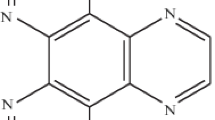Abstract
Previous studies indicate that ascorbic acid, when combined with copper or iron cleaves several viral DNA. ln this study, we generated the ascorbate radical anion electrochemically in a simple chemical environment without the participation of a metal ion. This solution possesses viral DNA scission activity. Ohe absence of catalytic metal ions [Fe (III) and Cu(II)] in the incubation medium was evidenced by metal chelating agents such as desferrioxamine and EDTA. Ohe radical quenching at high EDTA concentration was attributed to ionic strength of EDTA rather than metal chelation. Ohe effects of antioxidants, radical scavangers, catalase, superoxide dismutase and some proteins on DNA cleavage have been tested. Cleavage may not arise directly from ascorbate free radical but the reaction of the radical form of ascorbate with oxygen may produce the actual reactive species. Aerobic oxidation of ascorbate itself strictly requires transition metal catalysts, however electrochemically produced ascorbyl radical avoided the kinetic barrier that prevented direct oxidation of ascorbic acid with oxygen and eliminated the need for the transition metal ion catalysts.
Similar content being viewed by others
References
Arrigani O, Dipierro, S and Borraccino G 1981 Ascorbate free radical reductase; a key enzyme of the ascorbic acid system;FEBS Lett. 125 242–244
Bielski B H J 1982 Chemistry of ascorbate radicals; inAscorbic acid;Chemistry, metabolism and uses (eds) P A Seiob and B M Tolbert (Washington DC:American Chem. Soc.) pp 81–100
Bielski B H J, Comstock D A and Brown A R 1971 Ascorbic acid free radicals;J. Am.Chem. Soc. 93 5624–5629
Buettner, G R1988 In the absence of catalytic metals ascorbate does not autoxidize at pH 7: Ascorbate as a test for catalytic metals;J. Biochem, Biophys. Methods 16 27
Buettner G R 1990 The catalytic activity of iron in synovial fluid as monitored by the ascorbate free radical;Free Rad. Biol. Med. 8 55–56
Chiou S H 1983 DNA and protein-scission activities of ascorbate in the presence of copper ion and a copper-peptide complex;J. Biochem. 94 1259–1267
Chiou S H 1984 DNA-Scission activities of ascorbate in the presence of metal chelates;J. Biochem. 96 1307–1310
Chiou S H, Chang W H, Jou Y S, Chung H M M and Lo T B, 1985 Specific cleavage of DNA by ascorbate in the presence of copper ion or copper chelates;J. Biochem. 98 1723–1726
Chowdhury K 1991 One step ‘miniprep’ method for the isolation of plasmid DNA;Nucleic Acids Res,19 2792
Davidson A J and Kettle A J 1986 Mechanism of the inhibition of catalase by ascorbate;J. Biol. Chem. 261 1193–1200
Frohlinde D S 1983Radioprotectors and anticarcinogens (New York: Academic Press)
Fucs J, Mehihorn R J and Packer L 1990 Assay for free radical reductase activity in biological tissue by electron spin resonance spectrsocopy;Methods Enzymol. 186 670–674
Haliwell B and Aruoma 0 I 1991 DNA damage by oxygen-derived species. Its mechanism and measurement in mammalian systems;FEES Lett. 281 9–19
Haliwell B and Gutteiidge M C 1990 The importance of free radicals and catalytic metal ions in human diseases;Methods Enzymol. 186 l-85
Iyanagi T, Yamazaki I and Anan K F1985 One electron oxidation reduction properties of ascorbic acid;Biochim. Biophys. Acta 806 255–261
Miller M D, Buettner G R and Aust S D 1990 Transition metals as catalysts of autoxidation reactions;Free Rad. Biol. Med. 8 95–108
Orr W M 1967 Studies on ascorbic acid. Physical changes in catalase following incubation with ascorbate or ascorbate and copper(II);Biochemistry 6 3000–3006
önal A, ögus A and Kisaktirek D 1990 A new electrochemical method for the production of stable ascorbate free radicals;J. Biochim. Biophys. Methods 20 137–142
Paul V W, Kumar S, Fitzgerald P and Simpons R T 1987 Ascrobat potentiates DNA damage by 1-methyl-l-nitrosoureainvivo and generates DNA strand breaksin vitro;Carcinogenesis 8 1657–1662.
Shamberger R J 1984 Genetic toxicology of ascorbic acid;Mutation Res. 133 135–159
Sullivan M A, Yasbin R E and Young F E 1984 New shuttle vectors forBacillus subtilis andE. coli which allow rapid detection of inserted fragment;Gene 29 21–26
Tulius T D, Dombroski M E, Churchill A and Kam L 1987 Hydroxyl radical footprinting: A high-resolution method for mapping protein-DNA contacts;Methods Enzymol. 155 537–558
Wang Y and Ness B V 1989 Site specific cleavage of supper coiled DNA by ascorbate-Cu(II);Nucleic Acid Res. 17 6915–6926
Author information
Authors and Affiliations
Rights and permissions
About this article
Cite this article
Erdem, G., öner, C., önal, A.M. et al. Free radical mediated interaction of ascorbic acid and ascorbate/Cu(II) with viral and plasmid DNAs. J Biosci 19, 9–17 (1994). https://doi.org/10.1007/BF02703463
Received:
Revised:
Issue Date:
DOI: https://doi.org/10.1007/BF02703463




